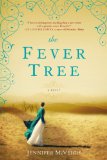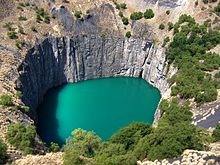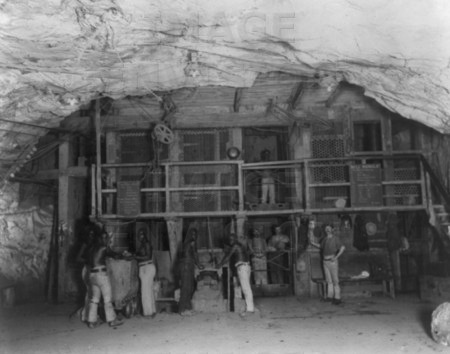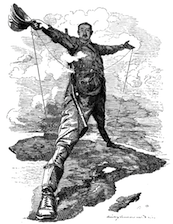Summary | Excerpt | Reading Guide | Reviews | Beyond the Book | Read-Alikes | Genres & Themes | Author Bio

Critics' Opinion:
Readers' Opinion:
First Published:
Apr 2013, 432 pages
Paperback:
Feb 2014, 448 pages
 Book Reviewed by:
Book Reviewed by:
Sarah Sacha Dollacker
Buy This Book
This article relates to The Fever Tree
The discovery of diamonds in Kimberley changed the course of South African history. Prior to this find, South Africa was a colonial outpost that was sparsely populated by Europeans and native tribes.
The Dutch East India Company established a colony at the Cape of Good Hope in 1652 with the purpose of resupplying Company ships. Initially they had no interest in developing the hinterland but found that they needed to increase food supplies so released some of the Dutch farmers, known as Boers, from their contracts allowing them to set up farms which would supply the colony and ships. By 1806, when Dutch colonial power gave way to British control, the Boers had established control over large tracts of land but, being fiercely independent and taking issue with British policies, many moved deeper into the African interior settling in areas that the British would later recognize in the 1850s and 60s as independent Boer Republics - the Transvaal and the Orange Free State.
Just to the west of the Orange Free State was an area that became known as Griqualand West populated by the Griqua (a semi-nomadic nation of mixed race origin). The capital of Griqualand West was Kimberley, close to the Vaal River. Small diamonds had been found near the Vaal River since the 1830s, attracting some diggers. But it was not until a 22-carat diamond was found in 1866, followed by an 83-carat diamond in 1869, that the worldwide frenzy for diamonds began. Tensions in the region flared when the Orange Free State annexed Griqualand West and set up an administration that failed to please the Griqua, the diggers or, in fact, the Orange Free State itself.
 The British Governor was asked to mediate and ruled in favor of the Griqua. Nicholas Waterboer, the Griqua leader, offered to place the territory under British administration - an offer that was accepted with alacrity in late 1871. Meanwhile, thousands from all over the world flocked to Kimberley to find diamonds. South Africa, which had been an agrarian society just barely making contact with the rest of the world, became an international industrial society. Kimberly expanded to a town of 50,000 within five years.
The British Governor was asked to mediate and ruled in favor of the Griqua. Nicholas Waterboer, the Griqua leader, offered to place the territory under British administration - an offer that was accepted with alacrity in late 1871. Meanwhile, thousands from all over the world flocked to Kimberley to find diamonds. South Africa, which had been an agrarian society just barely making contact with the rest of the world, became an international industrial society. Kimberly expanded to a town of 50,000 within five years.
At first European colonists and Africans worked individual claims in the mines. The Europeans soon found it advantageous to consolidate claims, pushing the native miners out, and making more profit. Laws were passed that forbade Africans from owning their own claims or trading their products. Africans were also forced to live in segregated camps and carry passes, which limited where they could travel. Although the Apartheid laws would not be passed until the 1940s, some historians see their roots in the diamond mines of the late 19th century. As the digging went deeper, it became more difficult to keep the claims separate. This is illustrated by the Big Hole (pictured above) - which started as a hill before becoming an open-pit and underground mine with a one mile perimeter. Also known as the Kimberley Mine it was worked by over 50,000 miners between 1871 and 1914. Local lore is that it is the largest hand dug hole in the world, but apparently that honor is taken by the Jagersfontein Mine, another diamond mine about 100 miles South-East of Kimberley.
 The leading actor in the development of diamond mining in South Africa was Englishman Cecil Rhodes. Rhodes arrived in South Africa as a sickly 16-year-old, sent there by his family in the hope that his health would improve. Two years later, Rhodes and his brother left for Kimberley and, with the help of finance from the Rothschild family, started to buy up all the small diamond operations in the Kimberley area.
The leading actor in the development of diamond mining in South Africa was Englishman Cecil Rhodes. Rhodes arrived in South Africa as a sickly 16-year-old, sent there by his family in the hope that his health would improve. Two years later, Rhodes and his brother left for Kimberley and, with the help of finance from the Rothschild family, started to buy up all the small diamond operations in the Kimberley area.  By 1889 Rhodes' DeBeers Consolidated Company had a monopoly on what was then pretty much the world's diamond supply. Rhodes would use his expansive wealth to influence politics in South Africa, becoming premier of Cape Colony in 1890. He also lent his name to the territory of Rhodesia (now the country of Zimbabwe) - which, apparently was a case of formalizing the name that the settlers in the area had been using for some years - indicating the popularity of Rhodes with many settlers.
By 1889 Rhodes' DeBeers Consolidated Company had a monopoly on what was then pretty much the world's diamond supply. Rhodes would use his expansive wealth to influence politics in South Africa, becoming premier of Cape Colony in 1890. He also lent his name to the territory of Rhodesia (now the country of Zimbabwe) - which, apparently was a case of formalizing the name that the settlers in the area had been using for some years - indicating the popularity of Rhodes with many settlers.
Today, he is probably best remembered for his endowment of the world's first international study program, the Rhodes Scholarship, that enables exceptional students from former British colonies and Germany to study at Oxford University.
Filed under Places, Cultures & Identities
![]() This "beyond the book article" relates to The Fever Tree. It originally ran in June 2013 and has been updated for the
February 2014 paperback edition.
Go to magazine.
This "beyond the book article" relates to The Fever Tree. It originally ran in June 2013 and has been updated for the
February 2014 paperback edition.
Go to magazine.





The Funeral Cryer by Wenyan Lu
Debut novelist Wenyan Lu brings us this witty yet profound story about one woman's midlife reawakening in contemporary rural China.
Your guide toexceptional books
BookBrowse seeks out and recommends the best in contemporary fiction and nonfiction—books that not only engage and entertain but also deepen our understanding of ourselves and the world around us.